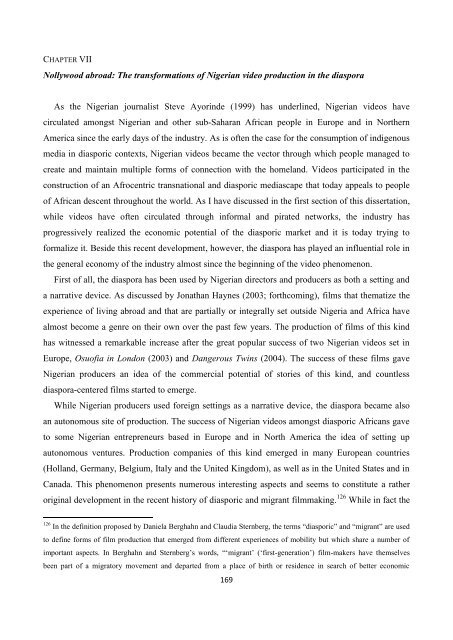You also want an ePaper? Increase the reach of your titles
YUMPU automatically turns print PDFs into web optimized ePapers that Google loves.
CHAPTER VI<strong>IN</strong>ollywood abroad: The transformations of Nigerian video production in the diasporaAs the Nigerian journalist Steve Ayorinde (1999) has underlined, Nigerian videos havecirculated amongst Nigerian and other sub-Saharan African people in Europe and in NorthernAmerica since the early days of the industry. As is often the case for the consumption of indigenousmedia in diasporic contexts, Nigerian videos became the vector through which people managed tocreate and maintain multiple forms of connection with the homeland. Videos participated in theconstruction of an Afrocentric transnational and diasporic mediascape that today appeals to peopleof African descent throughout the world. As I have discussed in the first section of this dissertation,while videos have often circulated through informal and pirated networks, the industry hasprogressively realized the economic potential of the diasporic market and it is today trying toformalize it. Beside this recent development, however, the diaspora has played an influential role inthe general economy of the industry almost since the beginning of the video phenomenon.First of all, the diaspora has been used by Nigerian directors and producers as both a setting anda narrative device. As discussed by Jonathan Haynes (2003; forthcoming), films that thematize theexperience of living abroad and that are partially or integrally set outside Nigeria and Africa havealmost become a genre on their own over the past few years. The production of films of this kindhas witnessed a remarkable increase after the great popular success of two Nigerian videos set inEurope, Osuofia in London (2003) and Dangerous Twins (2004). The success of these films gaveNigerian producers an idea of the commercial potential of stories of this kind, and countlessdiaspora-centered films started to emerge.While Nigerian producers used foreign settings as a narrative device, the diaspora became alsoan autonomous site of production. The success of Nigerian videos amongst diasporic Africans gaveto some Nigerian entrepreneurs based in Europe and in North America the idea of setting upautonomous ventures. Production companies of this kind emerged in many European countries(Holland, Germany, Belgium, Italy and the United Kingdom), as well as in the United States and inCanada. This phenomenon presents numerous interesting aspects and seems to constitute a ratheroriginal development in the recent history of diasporic and migrant filmmaking. 126 While in fact the126 In the definition proposed by Daniela Berghahn and Claudia Sternberg, the terms “diasporic” and “migrant” are usedto define forms of film production that emerged from different experiences of mobility but which share a number ofimportant aspects. In Berghahn and Sternberg’s words, “‘migrant’ (‘first-generation’) film-makers have themselvesbeen part of a migratory movement and departed from a place of birth or residence in search of better economic169
















